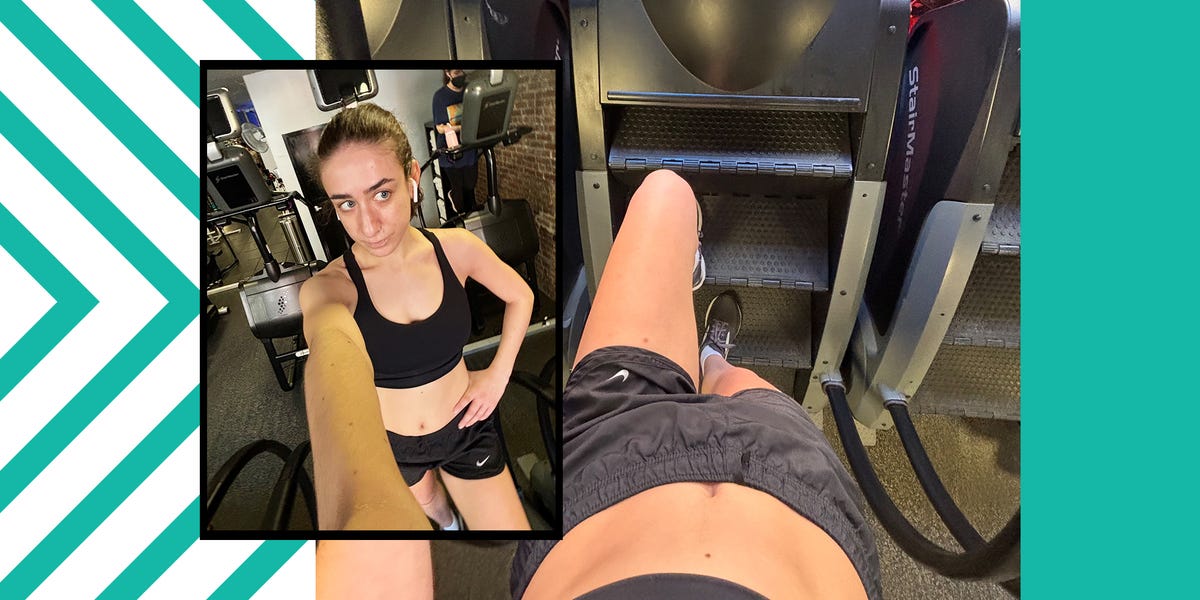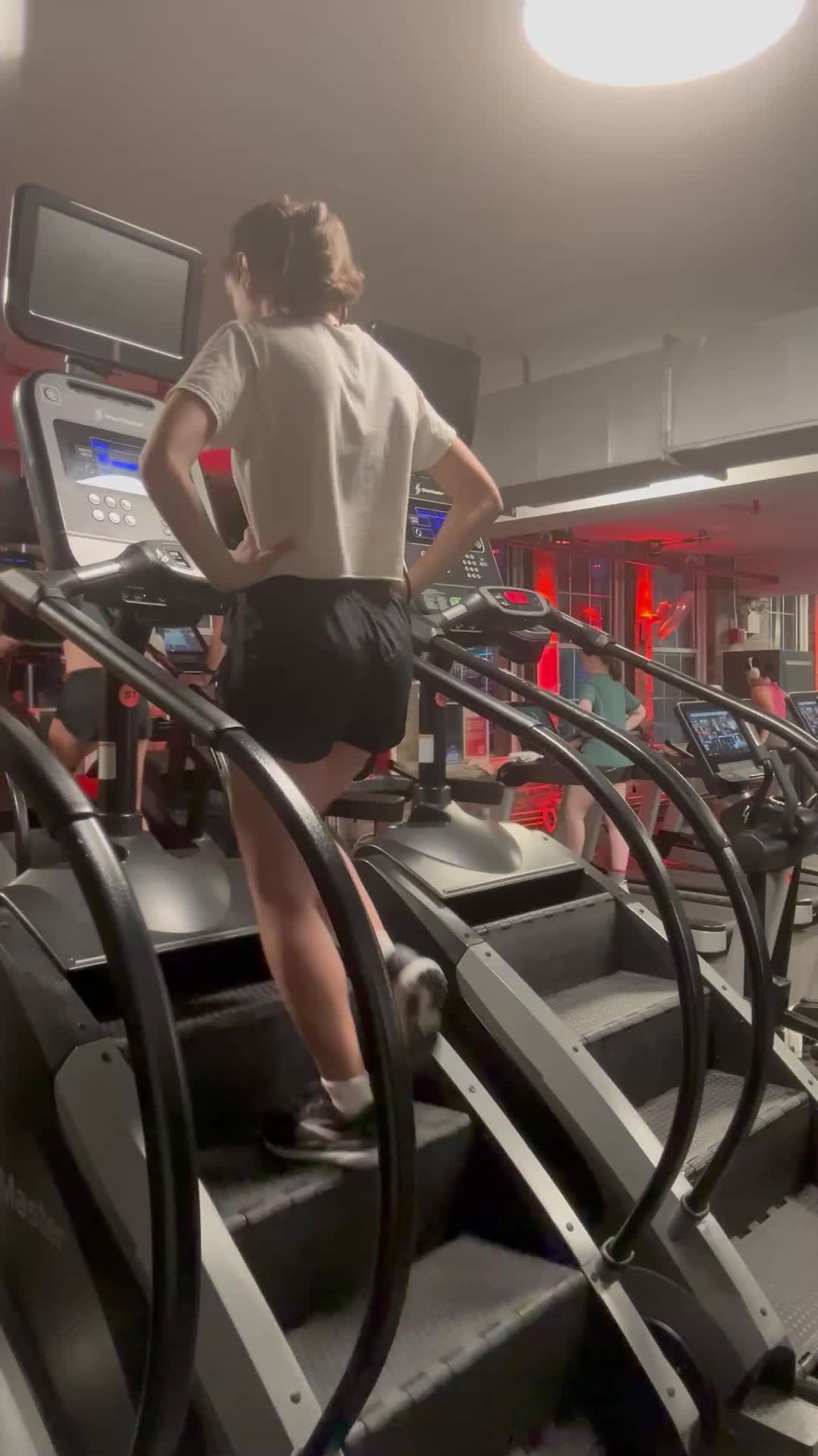When I first got my gym membership after moving to New York City, I was shocked to see that so many of my fellow gym-goers used the stair climber during their workouts. As someone who lives in a walk-up apartment, the act of climbing stairs feels much more like a daily chore than an exercise I’d willingly do in my free time. But between the viral 25-7-2 StairMaster workout and the sheer amount of people I saw using it at the gym, I started to think twice.
A little research revealed to me that the stair climber is a worthwhile machine to help you build cardiovascular endurance and strengthen your legs. It’s also lower-impact and easier on your joints than running—and as someone who was diagnosed with inflammatory arthritis at 21, that was enough to convince me to try out the stairway to heaven (or, at least, super-fit glutes) for myself. So, I decided to see if I could turn this demanding everyday task into something more and set a goal to spend 15 minutes every day on the stair climber for two weeks.
As a beginner stair climber user, I reached out to Gabrielle Savary, CPT—a professional bodybuilder, head coach at Grow With Gab Fitness, and part of the WH Strength in Diversity class of 2024—to get some tips. Everyone from seasoned athletes to fitness beginners can benefit from using the stair climber, she says. When you’re using the stair climber, you’re using your calves, hamstrings, quads, and core all at the same time. (Talk about bang for your buck.) And, since you can choose your own level, or the speed at which the stairs move, you can really do a workout at your own pace.
Meet the expert: Gabrielle Savary, CPT, is a professional bodybuilder, head coach at Grow With Gab Fitness, and a member of WH’s Strength in Diversity class of 2024.
“The stair climber challenges your cardiovascular [system] in a different way than the treadmill, elliptical, or other cardio machines,” says Savary. With each step, your muscles are working up against gravity compared to walking forward on a treadmill. To sustain this level of force, your heart rate will increase—but unlike running, cardio on the stair climber is low-impact.
I’m not a gym rat by any means—I’m more of a gym mouse. I like sticking to the corners of the gym and rarely stray from my usual routine of treadmill, weights, and core. My main goals are to be able to run five miles and to have enough core and leg strength to hold my own during drop-in ballet. I hypothesized that doing the stair climber on a regular basis would help me reach these goals—and, spoiler alert: I was right.
Alexa, play “Running Up That Hill.”
Here’s exactly what I did on the stair climber.
Throughout my stair climber challenge, I tried a ton of different approaches: walking at one speed the whole time, increasing my speed by one level every minute until failure, and walking at intervals. I wound up settling on a routine of five minutes of warm-up walking followed by ten minutes of intervals, mostly because it was the most mentally stimulating.
TBH, day one on the stair climber was a lot. I started all the way at level eight right off the bat, which turned out to be a rookie mistake. I was shocked at how fast my heart was beating, and, frankly, how much I was sweating. Admittedly, I had to stop-and-start my way through the 15 minutes. Despite my legs feeling like jelly when I stepped off the machine, I didn’t experience much soreness the next day, making this challenge all the more sustainable because fatigue didn’t keep me from being able to workout 24 hours later. Besides a slight ache in my glutes and hips, my body felt pretty good. (Throughout my two weeks, soreness really only occurred when I’d done a stair climber workout and a lifting workout in the same gym session—but more on that later.)
Over days two through six, I got comfortable with walking at levels six and seven, and found I could work up to higher levels (eight and nine) after warming up for a while. I also found out that really getting the most out of the stair climber is part mental game and learned to navigate accordingly. Listening to music that matched the speed of my walking made the workout more interesting and bearable, and draping a t-shirt over the dashboard so I couldn’t see how long I’d been walking helped pass the time too.
Form tip: Make sure to keep your chest up, core engaged, and arms by your sides for proper form, says Savary. No matter how tired you’re feeling, try not to hunch over onto the railings (guilty!). If you really do feel like you need to use your hands for stability, make sure you’re keeping as light a hold as possible, and maintaining good posture with your back straight up.
By day seven, I could comfortably walk at speeds of nine, 10, and 11 for a couple minutes at a time before dropping back down to levels six and seven, which is something I could not have done on day one. I also noticed that the workout was becoming more enjoyable, and 15 minutes began to feel more like five minutes. By the end of my fortnight of fortitude, I noticed significant changes in my mind and body, and felt like I had mastered the machine.
All Of The Changes I Noticed After Two Weeks Of Using The Stair Climber
1. My cardiovascular endurance improved.
Aside from the stair climber workout getting easier every time I did it, the endurance I developed carried over into other aspects of my life. After the challenge, running my go-to three-mile loop felt way easier than it had before, and I wasn’t as out of breath after I was done. I noticed that the uphill parts of my run didn’t feel as dramatic, and at times I even forgot that I was running uphill.
Regardless of whether or not you’re not a runner, the stair climber has loads of health benefits. Stair climbing is associated with a lower risk of heart diseases, and improved blood glucose and cholesterol levels, per a 2024 study in the Journal of Cognitive Enhancement.
2. My legs felt notably stronger.
After only a few days, my calves, hamstrings, and glutes started to feel more muscular. In my weekly ballet class, I felt like I could keep my leg up in the air longer at the barre, and didn’t experience as much soreness the day after class as I usually do.
I also noticed that the muscles in my legs—notably, my calves—really looked stronger and more defined. But according to Savary, you don’t stimulate muscle growth on the stair climber alone; you’d need progressive overload training to do that. However, Savary says that using the stairclimber as a warm-up before lifting—which I was doing throughout my experiment—can help you reap the benefits of leg day more fully.
“If I know we’re working out on a leg day, I’ll have [my client] hop on the stair climber first for 15 minutes to warm up because we’re pushing and forcing all of the blood into the muscles that we’re going to be working, which helps with muscle growth,” says Savary.
Using the stair climber helped me see results from my regular lifting exercises—single-leg deadlifts, squats, single-leg calf raises, and hamstring curls—that I hadn’t seen before. Let’s just say I’m sold; I will definitely continue to do the stair climber before leg day from now on.
3. As someone with a chronic condition, my body felt better after using the stair climber.
Like I said, I am one of those unlucky 23-year-olds with arthritis. Sometimes running or lifting is way too rough on my joints, and I opt for yoga or walking instead. Adding the stair climber to my gym repertoire allowed me to continue to develop my endurance and keep my cardiovascular system in shape even when I’m not feeling 100 percent.
I was a bit stiff on a few of my days using the stair climber, and found that 15 minutes of exercise, even on a low level, left me feeling way more loose and comfortable after my workout. Motion is lotion, baby. It also just gave me a mental reset on days I was in a bad mood; no matter how I felt walking into the gym, 15 minutes of fairly intense exercise lifted my spirits and made me feel happier and calmer.
4. Most importantly, I developed mental strength.
Like many things in life, the stair climber was an uphill battle; it wasn’t easy, but I pushed myself and did it anyway. It’s a great reminder that I always have the opportunity to challenge myself, and approach things both inside and outside of the gym with a growth mindset.
For me, the stair climber was as much a mental warm up as it was a physical one. After all, seeing that you have the ability to work against gravity for a substantial amount of time really makes you feel like you could conquer anything in the gym, says Savary. There’s research to back it up; the 2024 study in the Journal of Cognitive Enhancement also found that stair climbing can boost your mood and cognitive performance.
Doing this challenge made me think about the ways I talk to myself about exercise: often, I’ll say that “I’m not a runner” or “I’m not a lifter.” But, if I’m running on a regular basis, then I am a runner. If I’m lifting on a regular basis, I am a lifter. If I’m stair climbing on a regular basis, I am a StairMaster master. And if I can do it, you can too!
Halle Newman is a freelance journalist and copywriter based in New York City. When she’s not writing, she’s probably strolling through Central Park with a matcha or trying out a new dance class.
Read the full article here





